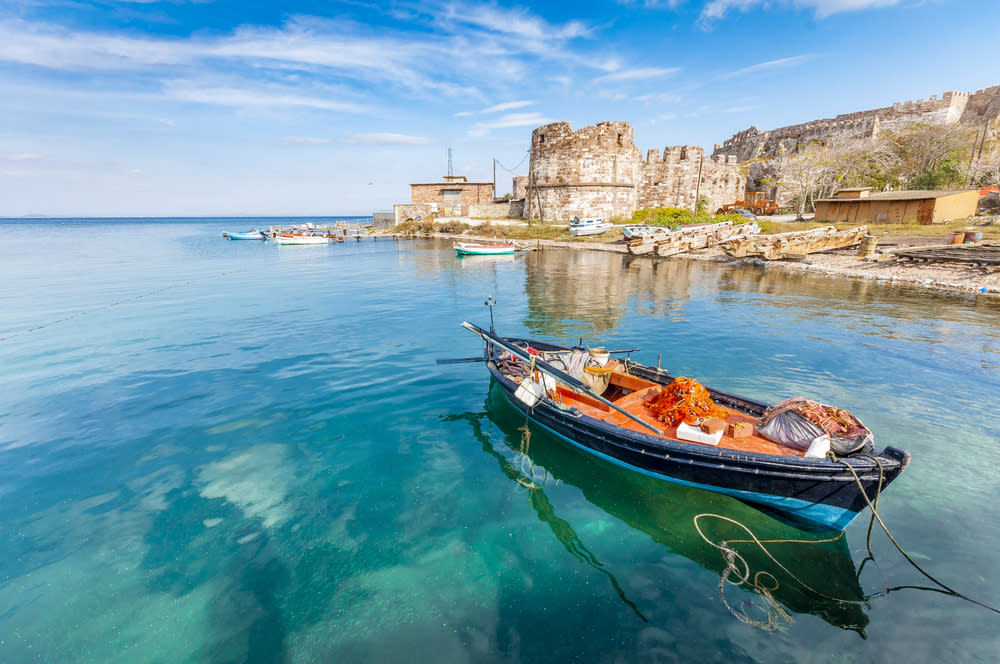More from Lesbos
Main Menu
- 00:00
- 06:00
- 12:00
- 18:00
- 23:00
Lesbos : Next 24-Hour Weather
Today - 18th April 2025
Sunrise 06:33
Sunset 19:56
Tomorrow - 19th April 2025
Sunrise 06:33
Sunset 19:56
Holiday Weather Now
Sorted by popularity:
Updated at 18:00 GMT
-
Temp feels like21°C70°F
-
Length of day13h 23m
-
Pressure29" (1012 hpa)
-
Visibility10 km (6miles)
-
Wind speed10 km/h
Sunrise 06:33
Sunset 19:56
-
Temp feels like:
21ºC (70 ºF)
-
Length of day:
13h 23m
-
Pressure:
29" (1012 hpa)
-
Visibility:
6 miles (10 km)
-
Wind speed:
10 km/h
Lesbos is the eighth largest island in the Mediterranean Sea and the third largest of the Greek Islands, after Crete and Evia. Although an extremely attractive, large island Lesbos (or Lesvos as its often called) has been relatively unscathed by the tourism masses that have trampled some of the more popular Greek holiday resorts. This also contributes to the island being significantly cheaper than many other Greek islands.
Located in the north eastern Aegean Sea, Lesbos enjoys a typical Mediterranean climate of long hot summers and mild winters. The average temperature on the island sits at a comfortable 18°C and it records about 750mm of annual rainfall. Year round the climate is generally moderate and enjoyable, temperature extremes really only occur in the height of summer and winter rarely sees temperatures that are extremely low. Lesbos is also known to be one of the sunniest islands in all of the Aegean.
Because of the size of the island and the presence of two large mountain ranges in the north and centre of the island, weather conditions vary in between regions of the island.
The island plays host to countless beaches, some excellent for day trips and some for stays of a few days to take in the relaxing island lifestyle. Petra and Molyvos in the north; Plomari in the northwest and Eresos southwest coasts are the most popular coastal towns, and the islands capital of Mytilene in the south east is the nearest city to the international airport.
The island is the route of migrating European birds coming from Africa so has an amazing variety of birds, making it a twitcher's paradise, particularly during Springtime. Springalso sees the island's wildflowers abloom. Lesbos has been appropriately termed the 'Emerald Island' in honour of its verdant landscape.
Summer
Summer on the island begins during May and carries on right through until October. In the peak of summer during July and August, the barometer can peak at 35°C to 40°C. The temperature will often see days reaching above 30°C in the middle six months of the year.
The heat in the height of summer can sometimes be oppressive, so if you like heat but don't want to live in a dry sauna then plan to visit the island in June or September. The heat is not as stifling and there is the added benefit of lower prices.
May and June see average temperatures of 20°C and 24°C respectively, while July and August each see an averages of 26°C before falling to 23°C in September. Keep in mind that these averages are misleading as the island gets scorching in the day and is cooled in the evenings by the sea breeze. This evening sea breeze brings a welcome break from the sometimes unbearable summer highs.
Sunshine levels are immense, peaking at 14 hours per day in July. May sees 10 and October seven still very sunny.
Rain during the months of June to September is basically nonexistent, with only about 23 mm precipitation recorded across the four months. May and October see 21mm and 38 mm respectively.
The island is scattered with many award winning beaches, ranging from the larger, more populated beaches of Petra down to the tiny, usually empty beaches of Campo Antissa beneath the mountains. So you can take your pick of many beaches to escape from the heat. In Lesbos the water temperature is generally about 5°C-10°C cooler than the air temperature, so may seem chilly at first but proves to be extremely refreshing.
Winter
Winters in Lesbos don't get particularly cold, especially on the coast. As you head up the mountains to higher altitudes however, temperatures drop and snow is often recorded. The snow very rarely survives in the low lying coastal towns. The average temperature throughout December is 12°C, falling to 10°C in January and February.
Winter is the island's rainy season, with rainfall at its peak in December. November, January and February also record high rainfall, with January being the second wettest month after December. While this is the wet season there is still plenty of sunshine as after showers the sky clears. This is largely unpredictable as sunny days can see a few short showers or the rain can set in for a five day stretch.
Many Greek islands basically close down completely for the winter and become ghost towns. Café's close, accommodation is scarce and the towns bear little resemblance to the buzzing tourist centres of the peak of summer. Because Lesbos is a large island with bigger cities that don't rely solely on tourism it is still a great place to visit in the winter.
Winter is olive-picking season in Greece and it is said that the best olives in the world come from Lesbos, so make the most of the island's 11 million olive trees and take a trip in the winter.
Lesbos is also famed for its large variety of birds and wildlife; winter is a great time to take part in bird watching and to explore the breathtaking natural side of the island.

















